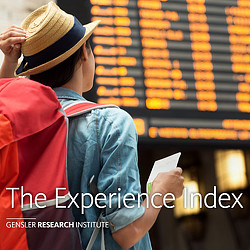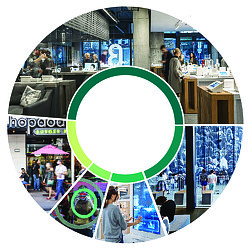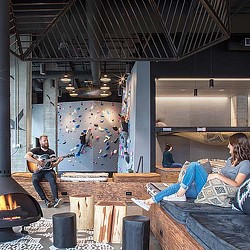Today’s consumers expect easy access to anything, regardless of where they are or what time it is. We sat down with Gensler’s Beth Novitsky to talk about how this idea of convergence and consumers’ heightened expectations for “everything, anytime” access is shaping brand design, and what Gensler and others should be doing to translate this mind-set into their work.
What does this idea of convergence mean to brands, and how is it shaping brand design?
Technology is everywhere, which means more seamlessness in our lives… but, ironically, we’re losing a sense of real human connectivity. So we look for more meaningful interactions to help provide that connection. In order to respond to this shift, brands need to think beyond products and services, and figure out how to articulate a lifestyle-centric point of view that can begin to provide meaning. It’s less about what you’re selling and more about what you stand for or how your values align with your customers.
Brands also need to understand that nowadays they’re dealing with an ecosystem, rather than one-off interactions. This is where the convergence comes in — it’s the same person doing all of these things, from shopping to working, to eating in a restaurant, to staying in a hotel on vacation. Our job in the Brand Design practice is to help define that ecosystem to be specific and relevant to that person.
How can brand designers translate the “always-on, anytime” consumer mind-set into their work?
I think it’s about making sure there are plenty of ways “in” to a brand story, so that consumers have the ability to discover for themselves. You can no longer control when, where, or how people will interact with your brand, so you have to make sure that every touch point is worthwhile. No one wants to feel like they’re being sold to, or lectured to, so the key is to put the consumer in the center of the conversation.
For that matter, maybe we need a new word instead of “consumer.” That implies someone who just consumes, or absorbs — information, products, experiences, etc. — when in fact, it’s a two-way street. Consumers have always had opinions and the ability to influence family and friends, but their power has exponentially increased. Now that we have the algorithmization and socialization of opinions, complete strangers in other states have the ability to influence purchases and change people’s perceptions. Successful brands have figured out ways of embracing this.
How are designers, developers, and brands all working to provide authentic and connected experiences among these converging forces?
Everyone cares about “experience,” but what does that word mean? It’s been used to describe everything from the user experience (or UX) of a digital interface to the highly emotional and multisensory feeling of being at a live event. But however you define it, there’s no doubt about the increasing importance of experience, and we actually have the data to back that up in our Gensler Experience IndexSM (EXI).
This research initiative taught us that good products alone are no longer enough to keep up with changing consumer habits, so being able to deliver a more holistic experience that engages people on multiple emotional levels is the thing that will differentiate one brand from another.
Is technology playing a bigger role in how people experience a brand?
Technology provides the underpinnings, but ideally it’s seamless and disappears into the background. The goal is transactions that are more efficient, and customers that feel more connected. I’m thinking of the work we did on the Taobao Choice Store in China, where digital screens “recognize” customers as they walk by and give you personalized recommendations. There aren’t any cash registers either — it’s a cashless system, so people get the item they want and walk out, and their Alipay accounts are automatically charged. When analog and digital experiences come together successfully like this, brands have the opportunity to strengthen and elevate their relationships with their customers.
But what’s often the most important thing about an experience? The place. To be specific, a well-designed place that will truly deliver on the promise. Our EXI research proves a direct connection between design and positive emotions, which have been proven to drive experience and engagement. When people are asked to evaluate a “good” experience, design is one component, along with factors like service, product quality, and technology. But when they evaluate an experience that exceeds expectations, that’s when key design factors such as beauty, authenticity, inspiration, sense of welcome, and novelty become critical. In other words, the more highly regarded an experience is, the greater role that design plays in the equation. That’s great news for designers everywhere!
You’ve written about the shift away from megabrands and the rise of microbrands that offer a clear point of view, targeted communication, and opportunities for customization. How has that changed over the past few years — or is it still the same?
I think that microbrands are continuing to proliferate. If anything, microbrands have evolved into something even more subtle. Look at the number of people who have become microbrands; Instagram influencers and bloggers whose sense of style has such a halo effect that they can basically make a living selling their life as a lifestyle.
These influencers are advocates for an entire ecosystem of affinity brands, places, events… and even social causes. They might not start out as household names, but they become famous because of their ability to articulate a specific point of view. We get a chance to peek into their world, as though we’re actually friends with them, and it seems effortless and intimate. But these people put just as much thought and purpose behind their brands as any corporate branding campaign… maybe even more, because their livelihoods literally depend on it! Another difference is that they start with themselves and then wrap their target audience to fit, rather than the other way around, like it is with most other brands. This creates the ultimate in authenticity.
What are some opportunities for brands amidst this changing consumer landscape?
It’s an exciting time for brands and, by extension, for designers like us who help to translate brands into experiences. We’re helping evolve brands to communicate a specific, lifestyle-oriented point of view, and transforming companies, in some cases entire communities, in the process. Strong, successful brands — whether they’re retail stores, universities, hospitals, or sports teams — are able to take advantage of the opportunity to create activated, engaged audiences. In turn, these people become brand evangelists and ambassadors, and co-create their favorite brands in the process.
Beth Novitsky is a Lifestyle Brand Design Leader and Design Director in Gensler’s New York office.




